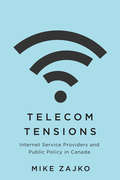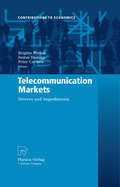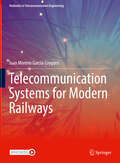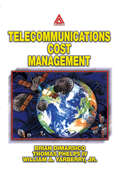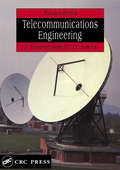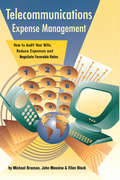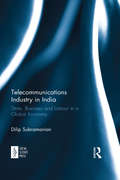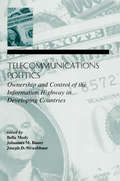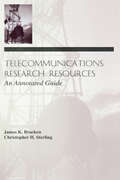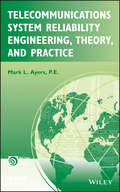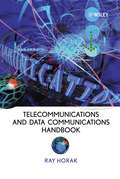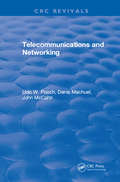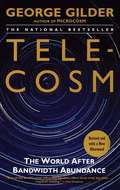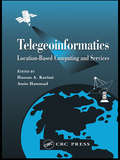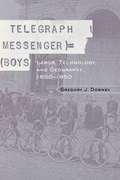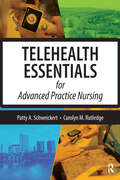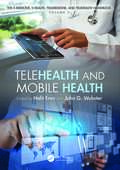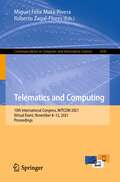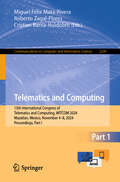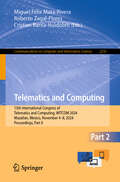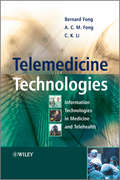- Table View
- List View
Telecom Tensions: Internet Service Providers and Public Policy in Canada
by Mike ZajkoToday's internet service providers mediate communication, control data flow, and influence everyday online interactions. In other words, they have become ideal agents of public policy and instruments of governance. In Telecom Tensions Mike Zajko considers the tensions inherent to this role – between private profits and the public good, competition and cooperation, neutrality and discrimination, surveillance and security – and asks what consequences arise from them.Many understand the internet as a technology that cuts out traditional gatekeepers, but as the importance of internet access has grown, the intermediaries connecting us to it have come to play an increasingly vital role in our lives. Zajko shows how the individuals and organizations that keep these networks running must satisfy a growing number of public policy objectives and contradictory expectations. Analyzing conflicts in Canadian policy since the commercialization of the internet in the 1990s, this book unearths the roots of contemporary debates by foregrounding the central role of internet service providers. From downtown data centres to publicly funded rural networks, Telecom Tensions explores the material infrastructure, power relations, and political aspirations at play.Theoretically informed but grounded in the material realities of people and places, Telecom Tensions is a fresh look at the political economy of telecommunications in Canada, updating conversations about liberalization and public access with contemporary debates over privacy, copyright, network neutrality, and cyber security.
Telecommunication Markets: Drivers and Impediments
by Peter Curwen Brigitte Preissl Justus HaucapTelecommunication markets are characterized by a dynamic development of technology and market structures. The specific features of network-based markets, convergence of previously separate spheres and the complex task of market regulation put traditional theoretical approaches as well as current regulatory policies to the test. This book sheds light on some of the challenges ahead. It covers a vast range of subjects from the intricacies of market regulation to new markets for mobile and internet-related services. The diffusion of broadband technology and the emergence of new business strategies that respond to the technological and regulatory challenges are treated in the book's 24 chapters.
Telecommunication Networks (Devices, Circuits, and Systems)
by Eugenio IannoneMany argue that telecommunications network infrastructure is the most impressive and important technology ever developed. Analyzing the telecom market’s constantly evolving trends, research directions, infrastructure, and vital needs, Telecommunication Networks responds with revolutionized engineering strategies to optimize network construction. Omnipresent in society, telecom networks integrate a wide range of technologies. These include quantum field theory for the study of optical amplifiers, software architectures for network control, abstract algebra required to design error correction codes, and network, thermal, and mechanical modeling for equipment platform design. Illustrating how and why network developers make technical decisions, this book takes a practical engineering approach to systematically assess the network as a whole—from transmission to switching. Emphasizing a uniform bibliography and description of standards, it explores existing technical developments and the potential for projected alternative architectural paths, based on current market indicators. The author characterizes new device and equipment advances not just as quality improvements, but as specific responses to particular technical market necessities. Analyzing design problems to identify potential links and commonalities between different parts of the system, the book addresses interdependence of these elements and their individual influence on network evolution. It also considers power consumption and real estate, which sometimes outweigh engineering performance data in determining a product’s success. To clarify the potential and limitations of each presented technology and system analysis, the book includes quantitative data inspired by real products and prototypes. Whenever possible, it applies mathematical modeling to present measured data, enabling the reader to apply demonstrated concepts in real-world situations. Covering everything from high-level architectural elements to more basic component physics, its focus is to solve a problem from different perspectives, and bridge descriptions of well-consolidated solutions with newer research trends.
Telecommunication Systems for Modern Railways (Textbooks in Telecommunication Engineering)
by Juan Moreno García-LoygorriThis textbook provides a comprehensive treatment of railway communications systems and their ever-evolving interconnectivity, smart systems, and complex grids. The author first provides an introduction to railways and goes on to detail wayside networks, onboard networks, safety systems, and services that rely on these networks. In particular, the book covers application aspects, including network and physical layer, maintenance, and technologies that will shape the railway of the future. The book also covers rolling stock networks and systems and details the railway ecosystem that will help people new to the topic understand the core material. The book is oriented to educational purposes in classes such as Intelligent Transportation Systems or Communication Systems Architectures and also for practicing railway engineers. The textbook features supplementary material including homework problems, exercises and more.
Telecommunications Cost Management
by William A. Yarberry Jr. Brian DiMarsico Thomas Phelps IVBusy decision-makers need the specifics quickly, without plowing through details that do not affect the economics of a project. Telecommunications Cost Management presents the key facts up front, with sample calculations for broadband, local access, equipment, and service alternatives. It provides a blueprint for cost reduction across all major technologies - from frame relay to IP telephony to contract recommendations. The text presents scenarios showing the effect of different architectural strategies for both voice and data communications. An Architectural Review lists alternatives to the traditional PBX and discusses how to minimize local access costs.
Telecommunications Engineering (Third Edition)
by John Dunlop<p>Since the publication of the second edition of this highly acclaimed textbook, telecommunications has progressed at a rapid rate. Major advances continue to occur in mobile communications and broadband digital networks and services, sophisticated signal processing techniques are prevalent at increasingly higher bit rates, and digital systems are widespread. These developments need to be addressed in a textbook that bridges the gap in the current knowledge and teachings of telecommunications engineering. <p>Telecommunications Engineering, 3rd Edition offers an introduction to the major telecommunications topics by combining an analytical approach to important concepts with a descriptive account of systems design. Completely updated and expanded, this third edition includes substantial material on integrated services digital networks, mobile communications systems, metropolitan area networks, and more.</p>
Telecommunications Expense Management: How to Audit Your Bills, Reduce Expenses, and Negotiate Favorable Rates
by Michael Brosnan John MessinaThis straightforward book will provide you with the insight necessary to save your organization revenue through the processes of bill auditing, expense reduction, and savvy contract negotiations. Information technology professionals will find the authors' suggestions useful, and yet uncomplicated to implement. After you have used their suggestions
Telecommunications Industry in India: State, Business and Labour in a Global Economy
by Dilip SubramanianTelecommunications Industry in India represents the first comprehensive study of a state-run enterprise in the telecommunications industry. The study traces over a period of half a century (1948-2009) the growth and decline of Indian Telephone Industries (ITI). At the heart of the monograph stands one central interrogation: How does the socio-technical system of production in a state-controlled firm shape the relations linking the four main actors: the state, management, union and workers? The original contribution of this book lies in combining business history and labour history within a single conceptual framework. The author evaluates the broader conclusions about the telecommunications industry and public sector through the lens of an individual firm to arrive at a more nuanced understanding of the dynamics of change in the globalizing Indian economy. The work is well in command of the literature on the global business history counterparts of ITI in the telecommunications industry. It is further strengthened by the use of French material on the subject which is now accessible for the first time in English. Please note: Taylor & Francis does not sell or distribute the Hardback in India, Pakistan, Nepal, Bhutan, Bangladesh and Sri Lanka
Telecommunications Politics: Ownership and Control of the information Highway in Developing Countries (Lea Telecommunications Ser.)
by Bella Mody Joseph D. Straubhaar Johannes M. BauerThis volume brings together scholars and policymakers to address the issue of telecommunications policy in developing countries. It elaborates on the position that economics and technology determine the framework for discussion, but politics makes the decision. Politics, in this case, refers to the dynamics of the power structure generated by the h
Telecommunications Research Resources: An Annotated Guide
by Christopher H. Sterling James K. BrackenAs the telecommunication and information field expands and becomes more varied, so do publications about these technologies and industries. This book is a first attempt to provide a general guide to that wealth of English-language publications -- both books and periodicals -- on all aspects of telecommunication. It is a comprehensive, evaluative sourcebook for telecommunications research in the United States that brings together a topically-arranged, cross-referenced, and indexed volume in one place. The information provided is only available by consulting a succession of different directories, guides, bibliographies, yearbooks, and other resources. On the one hand, it is a directory that describes in detail the major entities that comprise the American telecommunication research infrastructure including federal and state government offices and agencies, and private, public, and corporate research institutions. On the other hand, it is a bibliography that identifies and assesses the most important and useful reference and critical resources about U.S. telecommunication history, technology, industry and economics, social applications and impacts, plus policy, law and regulations, and role in the global telecommunication marketplace. No existing guide covers all of these aspects in the depth and detail of this volume.
Telecommunications System Reliability Engineering, Theory, and Practice (IEEE Press Series on Networks and Service Management #21)
by Mark L. AyersPractical tools for analyzing, calculating, and reporting availability, reliability, and maintainability metrics Engineers in the telecommunications industry must be able to quantify system reliability and availability metrics for use in service level agreements, system design decisions, and daily operations. Increasing system complexity and software dependence require new, more sophisticated tools for system modeling and metric calculation than those available in the current literature. Telecommunications System Reliability Engineering, Theory, and Practice provides a background in reliability engineering theory as well as detailed sections discussing applications to fiber optic networks (earth station and space segment), microwave networks (long-haul, cellular backhaul and mobile wireless), satellite networks (teleport and VSAT), power systems (generators, commercial power and battery systems), facilities management, and software/firmware. Programming techniques and examples for simulation of the approaches presented are discussed throughout the book. This powerful resource: Acts as a comprehensive reference and textbook for analysis and design of highly reliable and available telecommunications systems Bridges the fields of system reliability theory, telecommunications system engineering, and computer programming Translates abstract reliability theory concepts into practical tools and techniques for technical managers, engineers and students Provides telecommunication engineers with a holistic understanding of system reliability theory, telecommunications system engineering, and reliability/risk analysis Telecommunications System Reliability Engineering, Theory, and Practice is a must-have guide for telecommunications engineers or engineering students planning to work in the field of telecommunications Telecommunications System Reliability Engineering, Theory, and Practice is a must-have guide for telecommunications engineers or engineering students planning to work in the field of telecommunications.
Telecommunications and Data Communications Handbook
by Ray HorakFor an accessible and comprehensive survey of telecommunications and data communications technologies and services, consult the Telecommunications and Data Communications Handbook, which includes information on origins, evolution and meaningful contemporary applications. Find discussions of technologies set in context, with details on fiber optics, cellular radio, digital carrier systems, TCP/IP, and the Internet. Explore topics like Voice over Internet Protocol (VoIP); 802.16 & WiMAX; Passive Optical Network (PON); 802.11g & Multiple Input Multiple Output (MIMO) in this easily accessible guide without the burden of technical jargon.
Telecommunications and Empire (The History of Media and Communication)
by Jill HillsJill Hills picks up from her pathbreaking study The Struggle for Control of Global Communication: The Formative Century to continue her examination of the political, technological, and economic forces at work in the global telecommunications market from World War II to the World Trade Organization agreement of 1997. In the late twentieth century, focus shifted from the creation and development of global communication markets to their intense regulation. The historical framework behind this control--where the market was regulated, by what institution, controlled by what power, and to whose benefit--masterfully complements Hills's analysis of power relations within the global communications arena. Hills documents attempts by governments to direct, replace, and bypass international telecommunications institutions. As she shows, the results have offered indirect control over foreign domestic markets, government management of private corporations, and government protection of its own domestic communication market. Hills reveals that the motivation behind these powerful, regulatory efforts on person-to-person communication lies in the unmatched importance of communication in the world economy. As ownership of communications infrastructure becomes more valuable, governments have scrambled to shape international guidelines. Hills provides insight into struggles between U.S. policymakers and the rest of the world, illustrating the conflict between a growing telecommunications empire and sovereign states that are free to implement policy changes. Freshly detailing the interplay between U.S. federal regulation and economic power, Hills fosters a deep understanding of contemporary systems of power in global communications.
Telecommunications and Networking (Computer Science And Engineering Ser.)
by Udo W. PoochAs the dividing line between traditional computing science and telecommunications quickly becomes blurred or disappears in today's rapidly changing environment, there is an increasing need for computer professionals to possess knowledge of telecommunications principles. Telecommunications and Networking presents a comprehensive overview of the interaction and relationship between telecommunications and data processing. The book's early chapters cover basic telecommunications vocabulary, common nomenclature, telecommunications fundamentals, as well as the important relationships among coding, error detection and correction, and noise. Later chapters discuss such topics as switching, timing, topological structures, routing algorithms, and teleprocessing. Other topics covered in detail include specific concerns inherent to computer communications, such as protocols, error detection and correction, network monitoring and security, and system validation.System designers and programmers can no longer be effective simply by understanding the tradeoffs between hardware and software. Telecommunications and Networking provides both computing professionals and students the fundamental computer communications concepts necessary to function in today's computer industry.
Telecosm: How Infinite Bandwidth Will Revolutionize Our World
by George GilderThe computer age is over. After a cataclysmic global run of thirty years, it has given birth to the age of the telecosm -- the world enabled and defined by new communications technology. Chips and software will continue to make great contributions to our lives, but the action is elsewhere. To seek the key to great wealth and to understand the bewildering ways that high tech is restructuring our lives, look not to chip speed but to communication power, or bandwidth. Bandwidth is exploding, and its abundance is the most important social and economic fact of our time. George Gilder is one of the great technological visionaries, and "the man who put the 's' in 'telecosm'" (Telephony magazine). He is equally famous for understanding and predicting the nuts and bolts of complex technologies, and for putting it all together in a soaring view of why things change, and what it means for our daily lives. His track record of futurist predictions is one of the best, often proving to be right even when initially opposed by mighty corporations and governments. He foresaw the power of fiber and wireless optics, the decline of the telephone regime, and the explosion of handheld computers, among many trends. His list of favored companies outpaced even the soaring Nasdaq in 1999 by more than double. His long-awaited Telecosm is a bible of the new age of communications. Equal parts science story, business history, social analysis, and prediction, it is the one book you need to make sense of the titanic changes underway in our lives. Whether you surf the net constantly or not at all, whether you live on your cell phone or hate it for its invasion of private life, you need this book. It has been less than two decades since the introduction of the IBM personal computer, and yet the enormous changes wrought in our lives by the computer will pale beside the changes of the telecosm. Gilder explains why computers will "empty out," with their components migrating to the net; why hundreds of low-flying satellites will enable hand-held computers and communicators to become ubiquitous; why television will die; why newspapers and magazines will revive; why advertising will become less obnoxious; and why companies will never be able to waste your time again. Along the way you will meet the movers and shakers who have made the telecosm possible. From Charles Townes and Gordon Gould, who invented the laser, to the story of JDS Uniphase, "the Intel of the Telecosm," to the birthing of fiberless optics pioneer TeraBeam, here are the inventors and entrepreneurs who will be hailed as the next Edison or Gates. From hardware to software to chips to storage, here are the technologies that will soon be as basic as the air we breathe.
Telegeoinformatics: Location-Based Computing and Services
by Hassan A. Karimi Amin HammadTelegeoinformatics is a new discipline resulting from the integration of mobile computing with wired and wireless communications, geoinformatics (including GIS and GPS), and remote sensing techniques and technologies. Users of telegeoinformatics from every field will need a comprehensive reference to solve multiple types of problems involving locat
Telegraph Messenger Boys: Labor, Communication and Technology, 1850-1950
by Gregory J. DowneyIn Telegraph Messenger Boys Gregory J. Downey provides an entirely new perspective on the telegraph system: a communications network that revolutionized human perceptions of time and space. The book goes beyond the advent of the telegraphy and tells a broader story of human interaction with technology and the social and cultural changes it brought about.
Telegraph Messenger Boys: Labor, Technology, and Geography, 1850-1950
by Gregory J. DowneyThough providing a perspective on the telegraph system, a communications network that revolutionized human perceptions of time and space, this text's ramifications go far beyond just the telegraphy - it tells a broader story of human interaction with technology, and the social and cultural changes brought about by this interaction.
Telegraph to Telephone: Hello, World
by Nancy GallowayDid you know that writing letters used to be the only way to communicate with people far away? Samuel F.B. Morse changed all of that when he invented the telegraph and Morse code! Using wires and electromagnetism, Morse found a way to communicate over long distances almost instantly. This new technology paved the way for the telephone, as well as the other methods of communication we use today!
Telehealth Essentials for Advanced Practice Nursing
by Patricia Schweickert Carolyn RutledgeA timely, practical, and concise resource for advanced practice registered nursing (APRN) students, faculty, and providers, Telehealth Essentials for Advanced Practice Nursing provides readers with an understanding of and tools to embrace the emerging field of telehealth and optimize its application in clinical practice. Telehealth offers a unique solution to many health-care challenges, such as provider shortages, chronic disease management, an aging population, protection from infectious disease, and limited access to care. As telehealth is being incorporated into health care and health care delivery at an ever-increasing rate, APRNs that can navigate the telehealth arena are uniquely positioned to serve as leaders in the health care of the future. Using Telehealth Essentials for Advanced Practice Nursing, readers will learn how to utilize telehealth to provide new and innovative methods of care.Authors Patty A. Schweickert and Carolyn M. Rutledge present a multi-modal approach to telehealth education that layers telehealth onto nurses’ existing knowledge of nursing practice. The text begins with the history and basics of telehealth before moving on to critical content that a provider must understand to maximize its use in the health care arena, covering topics including: Technology used in the early response to infectious diseases such as COVID-19 The process of integrating telehealth in practice Laws, policies, and regulations governing telehealth practice Barriers to implementation and strategies for overcoming them Telehealth etiquette and ethics Using telehealth for effective interprofessional collaboration Each chapter includes group exercises, prompts for reflection, questions for discussion, and case studies. Included with the text are online supplemental materials for faculty use in the classroom.With Telehealth Essentials for Advanced Practice Nursing, APRN students, faculty, and practicing providers will learn to advocate for telehealth implementation, establish telehealth programs, and utilize telehealth to overcome barriers to care in order to optimize access and quality of care.
Telehealth and Mobile Health
by John G. Webster Halit ErenThe E-Medicine, E-Health, M-Health, Telemedicine, and Telehealth Handbook provides extensive coverage of modern telecommunication in the medical industry, from sensors on and within the body to electronic medical records and beyond. Telehealth and Mobile Health is the second volume of this handbook. Featuring chapters written by leading experts and
Telematics and Computing: 10th International Congress, WITCOM 2021, Virtual Event, November 8–12, 2021, Proceedings (Communications in Computer and Information Science #1430)
by Roberto Zagal-Flores Miguel Félix Mata-RiveraThis book constitutes the thoroughly refereed proceedings of the 10th International Congress on Telematics and Computing, WITCOM 2021, held in November 2021. Due to the COVID-19 pandemic the conference was held online. The 12 full papers and 7 short papers in this volume were carefully reviewed and selected from 48 submissions. The papers are focused on the topics of deep and machine learning, cybersecurity, wireless networks, computer vision, communications, and education applied to different sceneries of study and COVID-19.
Telematics and Computing: 13th International Congress of Telematics and Computing, WITCOM 2024, Mazatlan, Mexico, November 4–8, 2024, Proceedings, Part I (Communications in Computer and Information Science #2249)
by Roberto Zagal-Flores Miguel Félix Mata-Rivera Cristian Barria-HuidobroThis two-volume set constitutes the refereed proceedings of the 13th International Conference on Telematics and Computing , WITCOM 2024, which took place in Mazatlan, Mexico, during November 4–8, 2024. The 41 full papers presented in this volume were carefully reviewed and selected from 91 submissions. The papers focus on the topics of environment monitoring, information systems, IoT, education, artificial intelligence techniques, cybersecurity, data science, and energy, with applications to different case of study.
Telematics and Computing: 13th International Congress of Telematics and Computing, WITCOM 2024, Mazatlan, Mexico, November 4–8, 2024, Proceedings, Part II (Communications in Computer and Information Science #2250)
by Roberto Zagal-Flores Miguel Félix Mata-Rivera Cristian Barria-HuidobroThis two-volume set constitutes the refereed proceedings of the 13th International Conference on Telematics and Computing , WITCOM 2024, which took place in Mazatlan, Mexico, during November 4–8, 2024. The 41 full papers presented in this volume were carefully reviewed and selected from 91 submissions. The papers focus on the topics of environment monitoring, information systems, IoT, education, artificial intelligence techniques, cybersecurity, data science, and energy, with applications to different case of study.
Telemedicine Technologies
by C. K. Li Bernard Fong A.C.M. FongThis book brings together a broad range of topics demonstrating how information and wireless technologies can be used in healthcareIn this book, the authors focus on how medical information can be reliably transmitted through wireless communication networks. It explains how they can be optimized to carry medical information in various situations by utilizing readily available traditional wireless local area network (WLAN) and broadband wireless access (BWA) systems. In addition, the authors discuss consumer healthcare technology, which is becoming more popular as reduction in manufacturing cost of electronics products makes healthcare products more affordable to the general public. Finally, the book explores topics such as communication networks and services, patient monitoring, information processing, system deployment, data security and privacy, information technology in alternative medicine, multimedia and health informatics, and caring for the community. Key Features:Focuses on the transmission of medical information over wireless communication networks, and addresses topics such as communication networks and services, patient monitoring, information processing, system deployment, data security and privacy, and many others Provides an in-depth introduction to the various factors that need to be considered for supporting healthcare services with information technology Covers advancements in topics such as RFID in healthcare Discusses medical signal processing as well as ECG and signal processing techniques This book will be of interest to advanced students and professors in biomedical engineering, bioinformatics, and information engineering. Medical and IT professionals involved in specifying new facilities, healthcare practitioners in telemedicine, researchers in wireless communications and information technology, and network administrators will also find this book insightful.
